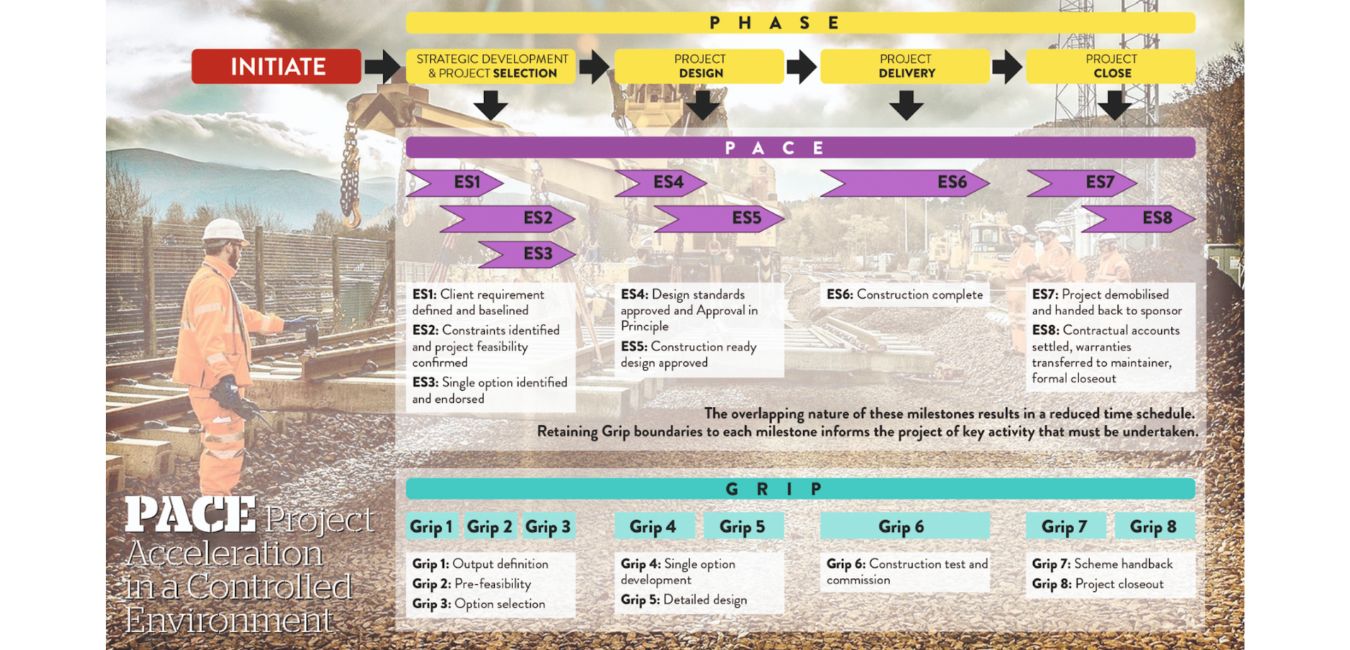GRIP, a project by Network Rail to help deliver efficiency improvements on the rail network, has been replaced by a new programme called PACE. It's been claimed that PACE will have an even greater impact than GRIP in delivering efficiency gains.
So what is PACE, and how does it differ from its predecessor?
PACE (Project Acceleration in a Controlled Environment) was approved by the Network Rail board in November 2020 after several months of testing. PACE is a new approach that will make it easier for Network Rail to integrate and respond to operational challenges. It will help the railway better cope with disruptions and ensure that projects are delivered on time and within budget.
It replaces GRIP, which was considered by some as overly complex and inefficient in its approach, resulting in additional costs being incurred. GRIP (Governance for Railway Investment Projects) had been used as a framework for managing projects since 2000. It involved eight 'stages' from feasibility through to operational handback.
The benefits of PACE are said to include:
- A simpler project management structure, which can be followed by all departments working on projects at any one time;
- Improved delegation of authority up the chain of command;
- A greater focus on risk management across all levels of the organisation;
- More effective use of key performance indicators (KPIs);
- A more coherent approach to procurement and contracting processes across different disciplines (including civil engineering works).
The changes are designed to create a simpler and more consistent approach to project management, which is needed given the current demands on the railway, according to Chris Rowley, Network Rail's director of NR2N (Network Rail 2nd Generation).
The new framework will be "a lot more flexible" than GRIP and will allow for more effective use of resources across projects. It will also encourage greater collaboration between teams working on different projects by allowing them to share lessons learned from previous work in order to improve delivery.
PACE has been created from Project SPEED (Swift, Pragmatic and Efficient Enhancement Delivery), itself part of the government’s Covid-19 recovery plan to deliver public investment projects faster and for less money.
In an article last year in New Civil Engineer, Mike Wright (Network Rail’s Capital Investment Programme Director) describes the aim of PACE “to keep the rigour of GRIP but not control projects so excessively that we are adding extra time and cost to the delivery.”
According to Wright, Grip was much more than a project lifecycle and there are hundreds of other processes, policies and governance controls across Network Rail that were affected by the Grip process.
One success story already realised using PACE is the restoration of the Dartmoor Railway Line, putting regular passenger services back on the line after more than 50 years. Led by Network Rail's Industry Programme Director Christian Irwin, the project moved quickly from feasibility to detailed design, enabling implementation of the works in April 202; a move from concept to construction in just 8 weeks.
The challenge now is to spread and scale that best practice across other programmes and the wider network.
Part of the PACE ethos is empowering and delegating authority to those best placed for decision making within the project team. Real time data is key to supporting this decision making Raildiary a potential best practice tool to help realise the benefits of Project SPEED and PACE.
Ultimately, the key to successful project delivery is choosing the right approach for the project at hand. By carefully considering the specific requirements of the project, and selecting the most appropriate approach, rail organizations can ensure that their projects are delivered to the required quality standards, on time and within budget. Whether using GRIP, PACE, or a combination of the two, the focus should always be on delivering value to the customer and achieving project success.





